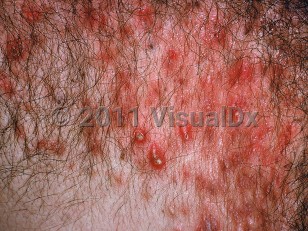Pathogenesis is thought to be primary occlusion of the pilosebaceous unit followed by rupture, with subsequent profound inflammatory response and frequent secondary infections. Lesions heal with scarring. Acne conglobata can run within families, and it typically affects pubertal adolescents and young adults. Women are affected less frequently than men.
Notably, the final morphologic outcome of resolved acne conglobata can be "secondary comedones." These have been compared to pseudocomedones, as are seen after healed lesions of hidradenitis suppurativa. This similarity (both clinically and histopathologically) suggests that chronic relapsing inflammatory processes that affect the follicular unit can ultimately be similar when healed.
Acne conglobata can present in isolation or as part of a systemic inflammatory condition, including the following syndromes:
- SAPHO syndrome (synovitis, acne, pustulosis, hyperostosis, and osteitis)
- PAPA syndrome (pyogenic arthritis, pyoderma gangrenosum, acne): Acne in PAPA syndrome can be severe and has been described in case reports as acne conglobata. This entity is caused by mutations in PSTPIP1. PSTPIP1 mutations have also been identified in a patient with PAPASH syndrome.
- PASH syndrome (pyoderma gangrenosum, acne, and suppurative hidradenitis): Arthritis is absent in this syndrome, as opposed to in PAPA and PAPASH. Additionally, mutations in PSTPIP1 have thus far not been detected in this entity.
- PAPASH syndrome (pyogenic arthritis, pyoderma gangrenosum, acne, and suppurative hidradenitis): Similar to PAPA syndrome but patients also have hidradenitis suppurativa. Just as in PAPA syndrome, PSTPIP1 mutations have also been identified in PAPASH syndrome.



